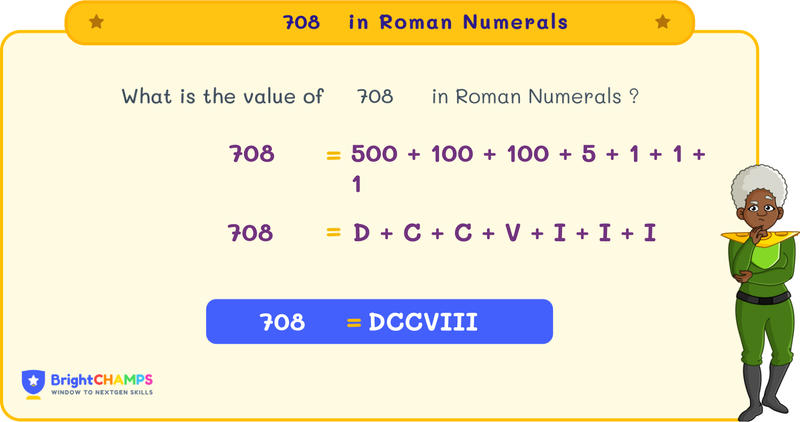


 130 Learners
130 LearnersLast updated on May 26th, 2025

708 in Roman Numerals

Roman numerals are a way of expressing numbers using symbols. The symbols used are I, V, X, L, C, D, and M. Roman numerals are commonly seen in royal titles, book names, sequences, and more. Here, we will discuss Roman numerals, their rules, and examples related to 708.
What is 708 in Roman Numerals?
Royal titles, such as Henry I, Henry II, and so on, often use Roman numerals. Have you noticed these symbols and wondered what they represent? Those are Roman numerals. In ancient times, people used fingers, sticks, and bones to count.
As life became more complex, a standard counting system was needed. Ancient Romans developed the Roman numeral system. The symbols we use are I (1), V (5), X (10), L (50), C (100), D (500), and M (1000).
In Roman numerals, 708 is represented as DCCVIII. Here, D is 500, C is 100, and VIII is 8. Let’s learn more about Roman numerals and how to write them.

Basic Rules for 708 in Roman Numerals
There are certain basic rules to write numbers in Roman numerals. Let's discuss some key rules that need to be remembered:
Rule 1: Addition Method
When a smaller number is placed after a larger one, it is the addition method. For example, VIII → V + III → 5 + 3 = 8.
Rule 2: Repetition Method
Certain Roman numerals can be repeated up to three times to represent larger numbers. For example, CCC → 300.
Rule 3: Subtraction Method
If a smaller number precedes a larger number, we subtract the smaller from the larger. For example, XC → X - C → 100 - 10 = 90.
Rule 4: Limitation Rule
Symbols cannot be repeated more than three times, and some symbols like V, L, and D cannot be repeated.
How to Write 708 in Roman Numerals
Let's learn how to write 708 in Roman numerals using the following methods:
- By Expansion Method
- By Grouping Method
708 in Roman Numerals by Expansion Method
In the expansion method, the number is broken down based on place value. Here's how to write 708 in Roman numerals:
Step 1: Break down 708 based on place values: 700 + 8.
Step 2: Convert each part into Roman numerals:
- 700 in Roman numerals is DCC (500 + 100 + 100).
- 8 in Roman numerals is VIII.
Step 3: Combine them: DCC + VIII = DCCVIII.
708 in Roman Numerals by Grouping Method
For large numbers, group them appropriately:
- 700 is DCC.
- 8 is VIII.
So, 708 is written as DCCVIII in Roman numerals.

Common Mistakes and How to Avoid Them in 708 Roman Numerals
Students often make mistakes when writing numbers in Roman numerals. Here are some common errors and how to avoid them:

708 in Roman Numerals Examples

Problem 1
A historian is cataloging ancient artifacts and finds that there are DLXV items in one collection and CXLIII items in another. What is the total number of artifacts in Roman numerals?

The total number of artifacts is DCCVIII
Explanation
To find the total number of artifacts, add the two numbers together.
DLXV = 565
CXLIII = 143
565 + 143 = 708
708 in Roman Numerals is DCCVIII

Problem 2
A library has a total of MCM books. If it distributes them evenly among XXVII shelves, how many books are on each shelf in Roman numerals?

Each shelf will have LXX books.
Explanation
Divide the total number of books by the number of shelves.
MCM = 1900
XXVII = 27
1900 / 27 = 70.37 (approximately 70 per shelf)
70 in Roman numerals is LXX.

Problem 3
A mathematician is studying patterns in sequences and writes down CCCLXV followed by CCCXLIII. What is the difference between the two sequences in Roman numerals?

The difference is XXII.
Explanation
Subtract the second sequence from the first.
CCCLXV = 365
CCCXLIII = 343
365 - 343 = 22
22 in Roman Numerals is XXII.

Problem 4
In a competition, a contestant scores CCCLXXX points in the first round and CCCXXVIII points in the second round. What is the contestant's total score in Roman numerals?

The total score is DCCVIII.
Explanation
Add the scores of the two rounds.
CCCLXXX = 380
CCCXXVIII = 328
380 + 328 = 708
708 in Roman Numerals is DCCVIII.

Problem 5
Convert the sum of 500 and 208 into Roman numerals using the expansion method.

The sum in Roman numerals is DCCVIII.
Explanation
First, convert the numbers into Roman numerals:
500 = D
208 = CCVIII
Add them together: 500 + 208 = 708
Using expansion: 708 = 700 + 8 = DCCVIII


FAQs on 708 in Roman Numerals
1.What is 700 in Roman numerals?
2.How to write 708 in Roman numerals?
3.What is 710 in Roman Numerals?
4.Is DCCVIII a prime number?
5.What are the multiples of 708?
Important Glossaries for 708 in Roman Numerals
- Addition Rule: When a larger numeral is followed by a smaller, their values are added. E.g., VIII = V + III = 8.
- Grouping Method: The number is grouped based on place value and converted into Roman numerals. E.g., 708 = 700 + 8 = DCCVIII.
- Repetition Rule: Certain symbols (I, X, C, M) can be repeated up to three times.
- Subtraction Method: Used when a smaller numeral precedes a larger one. E.g., XC = 90.
- Limitation Rule: Some symbols like V, L, and D are not repeated.
Explore More numbers
 Previous to 708 in Roman Numerals
Previous to 708 in Roman Numerals


Hiralee Lalitkumar Makwana
About the Author
Hiralee Lalitkumar Makwana has almost two years of teaching experience. She is a number ninja as she loves numbers. Her interest in numbers can be seen in the way she cracks math puzzles and hidden patterns.

Fun Fact
: She loves to read number jokes and games.



